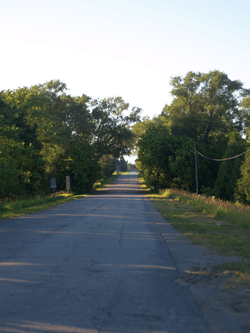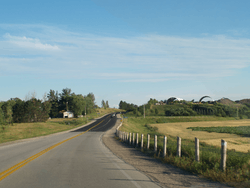Ontario Highway 27
King's Highway 27 is a short municipal highway in southern Ontario. Much of it is now cared for by the city of Toronto, York Region and Simcoe County. The Ministry of Transportation of Ontario was once responsible for the length of the route, when it ran through much of Southern Ontario. Now, only the southernmost 3 km (1.9 mi) from Dixon Road to Highway 427 is under provincial jurisdiction.[4]
| ||||
|---|---|---|---|---|
| York Regional Road 27 Simcoe County Road 27 | ||||
| Route information | ||||
| Maintained by City of Toronto the Regional Municipality of York and the County of Simcoe | ||||
| Length | 2.9 km[1] (1.8 mi) | |||
| Existed | September 14, 1927[2]–January 1, 1998[3] | |||
| Major junctions | ||||
| South end | ||||
| North end | End of divided highway north of Mimico Creek culvert | |||
| Highway system | ||||
| ||||
Route description

Highway 27 followed a mostly straight route throughout its length. North of Kleinburg, the vast majority of the highway was surrounded by rural farmland. South of there, it travelled through the suburbs of Toronto.
The highway began at off-ramps from the collectors lanes of Highway 427, which was redesignated from Highway 27 in 1972, as a four-lane divided expressway. Through Etobicoke, it encountered mostly industrial surroundings.
Within the Regional Municipality of York, Highway 27 travelled along the 9th concession road of Vaughan and King Township, approximately 16 km west of Yonge Street. It passed along the western edge of suburban sprawl in Vaughan, near the community of Woodbridge. South of Kleinburg, the highway dipped into the Humber River valley, connecting with Islington Avenue. North of the valley, it continued through King Township into the Oak Ridges Moraine, dividing the village of Nobleton and entering Schomberg immediately south of Highway 9, north of which the highway entered Simcoe County.
North of Highway 9, the route curved 1.5 km (0.93 mi) to the east, then continued north, parallel to Highway 400. It followed the townline between Tecumseth and West Gwillimbury townships. It travelled through the village of Bond Head and thereafter met Highway 89 in Cookstown. As the highway approached Barrie, it curved and followed Essa Road northeast until it met Highway 400. Through Barrie, it was concurrent with Highway 400 between Exit 94 and Exit 98, after which it was concurrent with Highway 26 along Bayfield Street, travelling north and exiting the city. At Midhurst, Highway 27 diverged from its concurrency to continue north, parallel to and 4 km (2.5 mi) west of Highway 400. After passing through the village of Elmvale and the end of Highway 92, the highway abruptly turned to the east to a junction with Highway 93 in the community of Waverley, which assumed the section north of here in the 1980s. Continuing north again, the highway meandered towards Georgian Bay, departing from the old Penetanguishene Road at Mertz's Corner. The route curved around the western side of a large marsh before entering the community of Wyebridge, where it crossed the Wye River. Several kilometres north of Wyebridge, Highway 27 met Highway 12 on the outskirts of Midland. It then rejoined Penetanguishene Road and continued north into Penetanguishene, ending at the shoreline of Penetanguishene Harbour.
History


Highway 27 was first designated between Barrie and Penetanguishene on September 14, 1927.[2] On March 28, 1934 it was extended south to Schomberg via county roads south of Barrie.[5] On August 12, 1936, Browns Line and Eaton Road were designated as part of Highway 27, creating an isolated section of the route between Long Branch and Elder Mills (at the modern intersection of Rutherford Road). On the same date, the road between Schomberg and Kleinburg was designated as part of Highway 27, leaving a gap between Elder Mills and Kleinburg, through the Humber valley. This gap was closed beginning in late 1936. It was completed and opened to traffic in 1938, bringing Highway 27 to its peak length of 148 km (92 mi). In the mid-1950s, the Toronto Bypass was constructed between Highway 2A and the Queen Elizabeth Way (QEW), widening Highway 27 to a four lane freeway in the process. This section was reconstructed again starting in 1968 and continuing until the early 1970s to turn it into a twelve-lane collector-express system. In mid-1972, the section of Highway 27 between the QEW and Eglinton Avenue was re-designated as Highway 427, and the remaining section of the highway following Browns Line from south of the QEW to Lake Shore Boulevard (then Highway 2) decommissioned.
On June 21, 1968, a new bypass north of Schomberg opened. Originally, northbound traffic had to turn east at Highway 9 then north at Leonard Road; a smooth curve is visible at this latter intersection, though it now forms the driveways of several residences. The new bypass made Highway 27 a through route at Highway 9.[6] The remainder of the route, from Eglinton Avenue north to Penetanguishene, was decommissioned on January 1, 1998.[3] It is still known as Highway 27 within Toronto, but is locally maintained. North of Toronto, it is known as Regional / County Road 27, depending on the jurisdiction.
Major intersections
The following table lists the major junctions along Highway 27, as noted by the Ministry of Transportation of Ontario. Former sections of Highway 27 are based upon lengths from the 1989 distance tables.[7]
| Division | Location[8] | km | mi | Destinations | Notes |
|---|---|---|---|---|---|
| Toronto | 0.0 | 0.0 | Southern end of provincially maintained section | ||
| 0.6 | 0.37 | Eglinton Avenue | Grade-separated interchange | ||
| 2.9 | 1.8 | Dixon Road | Grade-separated interchange; northern end of provincially maintained section and southern end of City of Toronto maintained section | ||
| 6.1 | 3.8 | Rexdale Boulevard | |||
| 9.3 | 5.8 | Albion Road | Formerly Highway 50 | ||
| 10.6 | 6.6 | Steeles Avenue | Northern end of City of Toronto maintained section; southern end of York Region maintained section | ||
| York | Vaughan | ||||
| 12.7 | 7.9 | Highway 7 was decommissioned through York Region on the same day as Highway 27 | |||
| Kleinburg | 20.7 | 12.9 | Formerly Highway 49 | ||
| 21.2 | 13.2 | Islington Avenue | |||
| Nobleton | 27.5 | 17.1 | |||
| King | 33.8 | 21.0 | Sideroad 17 | Formerly York Regional Road 15 | |
| 37.8 | 23.5 | ||||
| Schomberg | 38.5 | 23.9 | |||
| 39.9 | 24.8 | ||||
| Simcoe | Bradford West Gwillimbury | ||||
| 49.4 | 30.7 | Formerly Highway 88 | |||
| 50.8 | 31.6 | ||||
| Innisfil | 60.9 | 37.8 | |||
| Thornton | 69.7 | 43.3 | |||
| 70.2 | 43.6 | ||||
| Innisfil | 73.1 | 45.4 | Formerly Highway 131 and once the route of Highway 27 | ||
| Barrie | 80.0 | 49.7 | Exit 94 | ||
| 80.9 | 50.3 | Burton Avenue | Formerly Highway 11 | ||
| 82.9 | 51.5 | Dunlop Street West | Formerly Highway 90 | ||
| 83.2 | 51.7 | Dunlop Street East | Formerly Highway 11 and Highway 26 | ||
| 84.5 | 52.5 | Exit 98; Current eastern terminus of Highway 26[8] | |||
| Simcoe | Midhurst | 89.6 | 55.7 | ||
| 90.4 | 56.2 | ||||
| Springwater | 98.1 | 61.0 | |||
| Elmvale | 109.2 | 67.9 | Formerly Highway 92 | ||
| Saurin | 111.0 | 69.0 | |||
| Tay | 119.4 | 74.2 | |||
| Midland | 130.6 | 81.2 | Now northern terminus of Highway 93 and Highway 12; renumbered in the 1980s | ||
| Penetanguishene | 138.1 | 85.8 | Robert Street | Decommissioned in 1997 | |
| 1.000 mi = 1.609 km; 1.000 km = 0.621 mi | |||||
See also
References
- Ministry of Transportation of Ontario (2010). "Annual Average Daily Traffic (AADT) counts". Government of Ontario. Archived from the original on July 6, 2011. Retrieved June 6, 2013.
- "Appendix 6 - Schedule of Assumptions and Reversions of Sections". Annual Report (Report). Department of Highways. March 31, 1928. p. 60.
- Highway Transfers List - "Who Does What" (Report). Ministry of Transportation of Ontario. June 20, 2001. pp. 4, 13–14.
- http://www.gettorontomoving.ca/highway-27.html
- "Appendix 4 - Schedule of Assumptions and Reversions of Sections". Annual Report (Report). Department of Highways. March 31, 1935. p. 120.
- "New Highway 27 Bypass Opening" (Press release). Department of Highways. June 19, 1968.
- Ministry of Transportation of Ontario (April 1, 1989). Provincial Highways Distance Table. Government of Ontario. p. 53. ISSN 0825-5350.
- Ontario Back Road Atlas (Map). Cartography by MapArt. Peter Heiler. 2010. p. 24, 30, 41. § Z28–K31. ISBN 978-1-55198-226-7.
| Wikimedia Commons has media related to Ontario Highway 27. |


